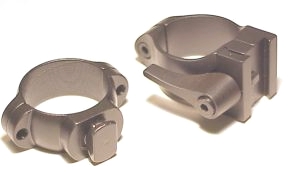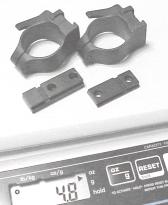 I have lots of guns that make lots of noise, which collectively can deliver megatons of energy. None are a first choice for a casual outing, nor are they the first choice for new shooter indoctrination. I thought it might be time to put together a fun gun, one I could use for the noted situation and for basic training. No, not that basic training, safety and shooting skills training.
I have lots of guns that make lots of noise, which collectively can deliver megatons of energy. None are a first choice for a casual outing, nor are they the first choice for new shooter indoctrination. I thought it might be time to put together a fun gun, one I could use for the noted situation and for basic training. No, not that basic training, safety and shooting skills training.
I picked a Remington Model Seven LS with a laminated stock and blued steel hardware. The rifle is compact, light and available in what I feel is a perfect centerfire chambering for my purposes, the .223 Remington. This particular model is one of the few new generation bolt guns that still has metallic sights, and is drilled and tapped for scope mounts. I wanted a rifle I could set up for either configuration, with the switch between metallic and optical as easy and reliable as possible, so a quick detachable mount system was required.
Warne scope mounts are manufactured in Clackamas, Oregon. The company markets a wide selection of quick detachable, and permanent mount systems for virtually every type of rifle application. There are three grades of Warne product; Magnum and Premium – machined from solid steel, and Maxima. Maxima is represented by Warne as a made from a “sintered steel process” which is actually precision casting or molding. Considering the same process is used to produce high performance engine connecting rods, they should hold up on most everyone’s favorite weekend boomer. I selected the Premium type because I am a solid steel snob, and I have an aversion to “space age materials”. I purchased the pieces from Brownells; a terrific company that always stocks all of the goofy stuff I buy, and always at fair prices.
 The ring at the left side of the photo is a Leupold standard. The ring does not protrude into the base, but rather sits flush on the base and is retained only by the clamping action of the small screw heads located on alternate sides of the base. The Warne quick detach ring, seen on the right, has a peg that protrudes down into the Warne base, and long side clamping/wedging surfaces to locate the ring solidly. The result is a design that resists lateral, longitudinal, vertical, and torsional forces. Neat. This is a weak spot in the standard Leupold base and allows the rear ring, scope included, bounce out with the gentle nudging of my .416 Weatherby. In fact it’s become a routine – 10 or 15 shots with 400 grain solids, then it’s stop and put the scope back on again. Very inconvenient.
The ring at the left side of the photo is a Leupold standard. The ring does not protrude into the base, but rather sits flush on the base and is retained only by the clamping action of the small screw heads located on alternate sides of the base. The Warne quick detach ring, seen on the right, has a peg that protrudes down into the Warne base, and long side clamping/wedging surfaces to locate the ring solidly. The result is a design that resists lateral, longitudinal, vertical, and torsional forces. Neat. This is a weak spot in the standard Leupold base and allows the rear ring, scope included, bounce out with the gentle nudging of my .416 Weatherby. In fact it’s become a routine – 10 or 15 shots with 400 grain solids, then it’s stop and put the scope back on again. Very inconvenient.
 The base in the background is the standard Leupold unit. In the foreground is the Warne standard two piece base, as used for fixed and detachable rings. The Leupold requires a base specifically for their QR, Quick Release rings. Leupold does offer two piece bases, although they are similar in thickness and heft to their one piece model. They do offer a twin dovetail base, and they do offer a Quick Detach base as premium priced options. Both companies offer extended bases to tailor the fit to short or long ring spacing, or overly long actions that might be difficult to fit to a typical scope tube length. The price of this detachable set up from Leupold is about $75 from discounters, about $95 for the Warne product.
The base in the background is the standard Leupold unit. In the foreground is the Warne standard two piece base, as used for fixed and detachable rings. The Leupold requires a base specifically for their QR, Quick Release rings. Leupold does offer two piece bases, although they are similar in thickness and heft to their one piece model. They do offer a twin dovetail base, and they do offer a Quick Detach base as premium priced options. Both companies offer extended bases to tailor the fit to short or long ring spacing, or overly long actions that might be difficult to fit to a typical scope tube length. The price of this detachable set up from Leupold is about $75 from discounters, about $95 for the Warne product.
 The whole Warne quick detach set up for a Weatherby or Remington rifle weighs only 4.8 ounces. A comparable set from Leupold weighs in at 6.6 ounces. I know this doesn’t seem like much weight, but at 80 g’s of recoil acceleration, that’s 144 ounces, or 9 more pounds interacting with the scope on the top of the rifle’s receiver. For the fanatical light weight rifle crowd, this savings of a few ounces means you can weld your bolt handle back on. Hot-damn!
The whole Warne quick detach set up for a Weatherby or Remington rifle weighs only 4.8 ounces. A comparable set from Leupold weighs in at 6.6 ounces. I know this doesn’t seem like much weight, but at 80 g’s of recoil acceleration, that’s 144 ounces, or 9 more pounds interacting with the scope on the top of the rifle’s receiver. For the fanatical light weight rifle crowd, this savings of a few ounces means you can weld your bolt handle back on. Hot-damn!
My next step is to install this set up on the Model Seven, and see how well it holds zero after the scope if removed and installed a few times. If all goes well, I will probably try a set of Warne Magnum mounts on one of the Weatherby rifles. They have Leupold mounts at the moment, one a dual dovetail setup and the other a standard base setup. The scope slips through the rings on the dual dovetail, and the scope slips and the rear rings have rub spots at the base connect points on the standard set up. My theory is weak ring clamping is responsible for both problems. Until I develop a better one, I’m sticking with it.
At the moment, I’m very much looking forward to this little .223, and maybe a chance to do some very inexpensive performance handloading. Actually, I think I still have a hundred rounds or so of hot loads left over from the T/C….

Email Notification